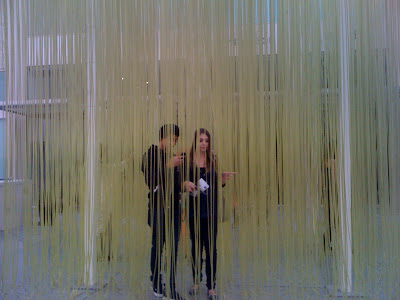
Friday, September 30, 2011
Sorry, no more entries this year

Monday, September 26, 2011
Grand Marshal Hector Tobar
 "As a Native of the East Hollywood, Hector Tobar grew up reading the Los Angelse Times. He devoured the sports pages, especially, but never thought he'd work at a paper his immigrant father occasionally delivered to make a little extra cash.
"As a Native of the East Hollywood, Hector Tobar grew up reading the Los Angelse Times. He devoured the sports pages, especially, but never thought he'd work at a paper his immigrant father occasionally delivered to make a little extra cash. Art here, art there



 http://www.fowler.ucla.edu/exhibitions/icons-invisible-oscar-castillo
http://www.fowler.ucla.edu/exhibitions/icons-invisible-oscar-castilloWednesday, September 21, 2011
Parade preparations continue...meanwhile at Villa Parke...
 At the moment the picture was taken we were seeing how SARA allows a patron to listen to or read in large print materials that is placed on a device that looks like a tape recorder and sort of works like a scanner. Except that the read out can be in different voices, the images can have different sized font - based on need, and the pace can be set by the user.
At the moment the picture was taken we were seeing how SARA allows a patron to listen to or read in large print materials that is placed on a device that looks like a tape recorder and sort of works like a scanner. Except that the read out can be in different voices, the images can have different sized font - based on need, and the pace can be set by the user. Monday, September 19, 2011
Llena de cultura/Full of Culture



Thursday, September 15, 2011
Latino Heritage Month, September 15-October 15
 Here's our poster for this year's event.
Here's our poster for this year's event. Tuesday, September 13, 2011
Celebrating a Culture of Hope and Progress

Sunday, September 11, 2011
Gilbert "Magu" Luján




El Paseo y El Pasado
In 1781, a mere 10 years after Mision San Gabriel was established, 44 pobladores (townspeople), men, women, and children, arrived at Yangna, an area where the Tongva had lived for generations and generations. Over the next 150 years the descendants of the pobladores and the Tongva saw vast changes in what became known as the city of Los Angeles.


http://www.image-archeology.com/Olvera_Street_Los_Angles_CA_009.jpg
For those whose parents and grandparents had come from Mexico, it was a place where you could see the jarabe tapatio, buy maracas, or eat taquitos. It was a place where spoken Spanish was permitted and where you could be proud to be a Mexican American.


Saturday, September 10, 2011
Fiestas Patrias in Pasadena

Friday, September 9, 2011
Yvonne Chavez Lombardi, 2011 Doña Eulalia Award Recipient

Thursday, September 8, 2011
Eulalia Pérez de Guillen de Mariné
 Cecilia Rasmussen is responsible for my first learning about Doña Eulalia some 13 years ago. Her LA Times "Then and Now" column was a very brief, but fascinating look at the centegenerian for whom Rancho el Rincon de San Pascual was reserved.
Cecilia Rasmussen is responsible for my first learning about Doña Eulalia some 13 years ago. Her LA Times "Then and Now" column was a very brief, but fascinating look at the centegenerian for whom Rancho el Rincon de San Pascual was reserved. Wednesday, September 7, 2011
Dr. Juan Francisco Lara, 2011 Community Grand Marshal
Juan Francisco Lara is a second generation Mexican American San Franciscan and a Pasadena resident since 1972. His wife Joanne was a Sister of the Immaculate Heart of Mary and a PUSD Teacher. They have a son, Ankarino, a daughter, Kiela, and three grandchildren Leotei, Kalyxtomar and Eisling. Lara’s career began in 1965. It's been one of teaching, mentoring, scholarship program development, curriculum and teacher professional development, public educational and community service, and the pursuit of access and equity to higher education for underrepresented racial and ethnic minority students.
He taught, coached baseball and theatre at De La Salle and taught at Cathedral HS when he was a Christian Brother. He also taught at Compton, East LA and Pasadena CC’s, the UCLA and Claremont Graduate Schools of Education and the UCI School of Social Science.
Tuesday, September 6, 2011
2011 Community Grand Marshal
 So you can easily see he is handsome, perhaps one might even call him debonair, but who is this person and why do you think he was chosen to be our Community Grand Marshal?
So you can easily see he is handsome, perhaps one might even call him debonair, but who is this person and why do you think he was chosen to be our Community Grand Marshal?“Si Se Puede!”




